|
SNAP Library 2.4, Developer Reference
2015-05-11 19:40:56
SNAP, a general purpose, high performance system for analysis and manipulation of large networks
|
|
SNAP Library 2.4, Developer Reference
2015-05-11 19:40:56
SNAP, a general purpose, high performance system for analysis and manipulation of large networks
|
#include <timenet.h>
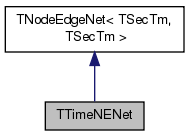
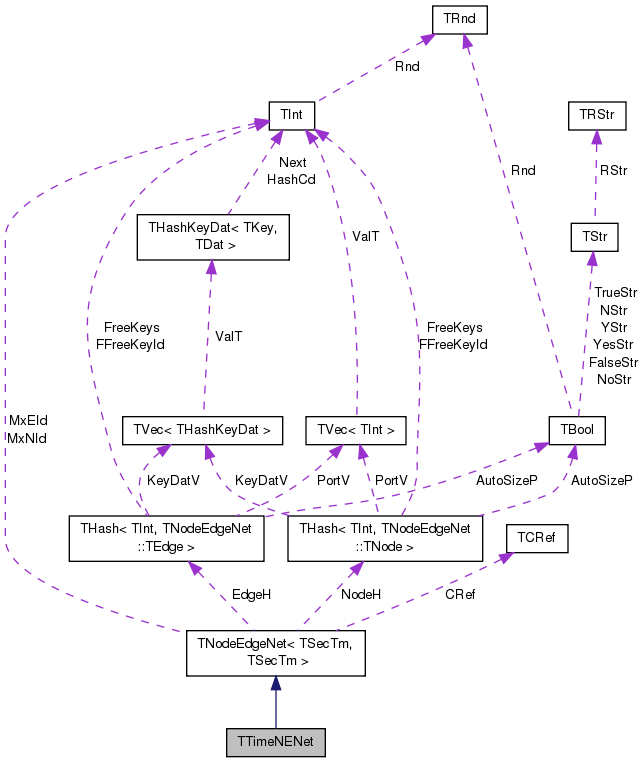
Public Types | |
| typedef TNodeEdgeNet< TSecTm, TSecTm > | TNet |
| typedef TPt< TNodeEdgeNet < TSecTm, TSecTm > > | PNet |
 Public Types inherited from TNodeEdgeNet< TSecTm, TSecTm > Public Types inherited from TNodeEdgeNet< TSecTm, TSecTm > | |
| typedef TSecTm | TNodeDat |
| typedef TSecTm | TEdgeDat |
| typedef TNodeEdgeNet< TSecTm, TSecTm > | TNet |
| typedef TPt< TNet > | PNet |
Public Member Functions | |
| TTimeNENet () | |
| TTimeNENet (const int &Nodes, const int &Edges) | |
| TTimeNENet (TSIn &SIn) | |
| TTimeNENet (const TTimeNENet &TimeNet) | |
| void | Save (TSOut &SOut) const |
| Saves the network to a (binary) stream SOut. More... | |
| TTimeNENet & | operator= (const TTimeNENet &TimeNet) |
| PTimeNet | GetTimeNet () const |
| PTimeNENet | Get1stEdgeNet () const |
| PTimeNENet | GetSubGraph (const TIntV &NIdV) const |
| PTimeNENet | GetESubGraph (const TIntV &EIdV) const |
| PTimeNENet | GetGraphUpToTm (const TSecTm &MaxEdgeTm) const |
| void | SortNodeEdgeTimes () |
| void | UpdateNodeTimes () |
| void | SetNodeTmToFirstEdgeTm () |
| void | SetRndEdgeTimes (const int &MinTmEdge=0) |
| void | DumpTimeStat () const |
| void | GetNIdByTm (TIntV &NIdV) const |
| void | GetEIdByTm (TIntV &EIdV) const |
| void | GetTmBuckets (const TTmUnit &GroupBy, TTimeNet::TTmBucketV &TmBucketV) const |
| void | GetEdgeTmBuckets (const TTmUnit &GroupBy, TTimeNet::TTmBucketV &TmBucketV) const |
| void | GetNodeBuckets (const int NodesPerBucket, TTimeNet::TTmBucketV &TmBucketV) const |
| void | GetEdgeBuckets (const int EdgesPerBucket, TTimeNet::TTmBucketV &TmBucketV) const |
| int | GetTriadEdges (TIntV &TriadEIdV) const |
| PGStatVec | TimeGrowth (const TTmUnit &TimeStep, const TFSet &TakeStat, const TSecTm &StartTm=TSecTm(1)) const |
| PGStatVec | TimeGrowth (const TStr &FNmPref, const TStr &Desc, const TFSet &TakeStat, const int &NDiamRuns, const TTmUnit &TmUnit, const int &TakeNTmUnits, const bool &LinkBWays) const |
| void | PlotEffDiam (const TStr &FNmPref, const TStr &Desc, const TTmUnit &GroupBy, const TSecTm &StartTm, const int &NDiamRuns=10, const bool &OnlyWcc=false) const |
| void | PlotMissingPast (const TStr &FNmPref, const TStr &Desc, const TTmUnit &TmUnit, const TSecTm &DelPreTmEdges, const TSecTm &PostTmDiam, const bool &LinkBWays) |
| void | SaveEdgeTm (const TStr &EdgeFNm, const bool &RenumberNId=false, const bool &RelativeTm=false) const |
 Public Member Functions inherited from TNodeEdgeNet< TSecTm, TSecTm > Public Member Functions inherited from TNodeEdgeNet< TSecTm, TSecTm > | |
| TNodeEdgeNet () | |
| TNodeEdgeNet (const int &Nodes, const int &Edges) | |
| Constructor that reserves enough memory for a network of Nodes nodes and Edges edges. More... | |
| TNodeEdgeNet (const TNodeEdgeNet &Net) | |
| TNodeEdgeNet (TSIn &SIn) | |
| Constructor that loads the network from a (binary) stream SIn. More... | |
| virtual | ~TNodeEdgeNet () |
| bool | HasFlag (const TGraphFlag &Flag) const |
| Allows for run-time checking the type of the network (see the TGraphFlag for flags). More... | |
| TNodeEdgeNet & | operator= (const TNodeEdgeNet &Net) |
| int | GetNodes () const |
| Returns the number of nodes in the network. More... | |
| int | AddNode (int NId=-1) |
| Adds a node of ID NId to the network. More... | |
| int | AddNode (int NId, const TSecTm &NodeDat) |
| Adds node data to node with ID NId. More... | |
| int | AddNode (const TNodeI &NodeI) |
| Adds a node NodeI and its node data to the network. More... | |
| void | DelNode (const int &NId) |
| Deletes node of ID NId from the network. More... | |
| void | DelNode (const TNode &NodeI) |
| Deletes node of ID NodeI.GetId() from the network. More... | |
| bool | IsNode (const int &NId) const |
| Tests whether ID NId is a node. More... | |
| TNodeI | BegNI () const |
| Returns an iterator referring to the first node in the network. More... | |
| TNodeI | EndNI () const |
| Returns an iterator referring to the past-the-end node in the network. More... | |
| TNodeI | GetNI (const int &NId) const |
| Returns an iterator referring to the node of ID NId in the network. More... | |
| void | SetNDat (const int &NId, const TSecTm &NodeDat) |
| Sets node data for the node of ID NId in the network. More... | |
| TSecTm & | GetNDat (const int &NId) |
| Returns node data for the node of ID NId in the network. More... | |
| const TSecTm & | GetNDat (const int &NId) const |
| Returns node data for the node of ID NId in the network. More... | |
| int | GetMxNId () const |
| Returns an ID that is larger than any node ID in the network. More... | |
| int | GetEdges () const |
| Returns the number of edges in the network. More... | |
| int | GetUniqEdges (const bool &IsDir=true) const |
| Returns the number of edges in the network with a unique pair of nodes. More... | |
| int | AddEdge (const int &SrcNId, const int &DstNId, int EId=-1) |
| Adds an edge between node IDs SrcNId and DstNId to the graph. More... | |
| int | AddEdge (const int &SrcNId, const int &DstNId, int EId, const TSecTm &EdgeDat) |
| Adds an edge and edge data from node IDs SrcNId to node DstNId. More... | |
| int | AddEdge (const TEdgeI &EdgeI) |
| Adds an edge from EdgeI.GetSrcNId() to EdgeI.GetDstNId() and its edge data to the network. More... | |
| void | DelEdge (const int &EId) |
| Deletes an edge with ID EId from the network. More... | |
| void | DelEdge (const int &SrcNId, const int &DstNId, const bool &IsDir=true) |
| Deletes an edge from node IDs SrcNId to DstNId from the network. More... | |
| bool | IsEdge (const int &EId) const |
| Tests whether an edge with ID EId exists in the network. More... | |
| bool | IsEdge (const int &SrcNId, const int &DstNId, const bool &IsDir=true) const |
| Tests whether an edge from node IDs SrcNId to DstNId exists in the network. More... | |
| bool | IsEdge (const int &SrcNId, const int &DstNId, int &EId, const bool &IsDir=true) const |
| Tests whether an edge from node IDs SrcNId to DstNId with edge ID EId exists in the network. More... | |
| int | GetEId (const int &SrcNId, const int &DstNId) const |
| TEdgeI | BegEI () const |
| Returns an iterator referring to the first edge in the network. More... | |
| TEdgeI | EndEI () const |
| Returns an iterator referring to the past-the-end edge in the network. More... | |
| TEdgeI | GetEI (const int &EId) const |
| Not supported/implemented! More... | |
| TEdgeI | GetEI (const int &SrcNId, const int &DstNId) const |
| Returns an iterator referring to edge (SrcNId, DstNId) in the graph. More... | |
| void | SetEDat (const int &EId, const TSecTm &EdgeDat) |
| Sets edge data for the edge of ID NId in the network. More... | |
| TSecTm & | GetEDat (const int &EId) |
| Returns edge data for the edge with ID EId. More... | |
| const TSecTm & | GetEDat (const int &EId) const |
| Returns edge data for the edge with ID EId. More... | |
| void | SetAllEDat (const TSecTm &EdgeDat) |
| Sets edge data for all the edges in the network to EDat. More... | |
| int | GetRndNId (TRnd &Rnd=TInt::Rnd) |
| Returns an ID of a random node in the network. More... | |
| TNodeI | GetRndNI (TRnd &Rnd=TInt::Rnd) |
| Returns an interator referring to a random node in the network. More... | |
| int | GetRndEId (TRnd &Rnd=TInt::Rnd) |
| Returns an ID of a random edge in the network. More... | |
| TEdgeI | GetRndEI (TRnd &Rnd=TInt::Rnd) |
| Returns an interator referring to a random edge in the network. More... | |
| void | GetNIdV (TIntV &NIdV) const |
| Returns a vector of all node IDs in the network. More... | |
| void | GetEIdV (TIntV &EIdV) const |
| Returns a vector of all edge IDs in the network. More... | |
| bool | Empty () const |
| Tests whether the network is empty (has zero nodes). More... | |
| void | Clr () |
| Deletes all nodes and edges from the network. More... | |
| void | Reserve (const int &Nodes, const int &Edges) |
| Reserves memory for a network of Nodes nodes and Edges edges. More... | |
| void | SortNIdById (const bool &Asc=true) |
| Sorts nodes by node IDs. More... | |
| void | SortNIdByDat (const bool &Asc=true) |
| Sorts nodes by node data. More... | |
| void | SortEIdById (const bool &Asc=true) |
| Sorts edges by edge IDs. More... | |
| void | SortEIdByDat (const bool &Asc=true) |
| Sorts edges by edge data. More... | |
| void | Defrag (const bool &OnlyNodeLinks=false) |
| Defragments the network. More... | |
| bool | IsOk (const bool &ThrowExcept=true) const |
| Checks the network data structure for internal consistency. More... | |
Static Public Member Functions | |
| static PTimeNENet | New () |
| static PTimeNENet | New (const int &Nodes, const int &Edges) |
| static PTimeNENet | Load (TSIn &SIn) |
| static PTimeNENet | GetSmallNet () |
| static PTimeNENet | GetGnmRndNet (const int &Nodes, const int &Edges) |
| static PTimeNENet | GetPrefAttach (const int &Nodes, const int &Edges, const double &GammaIn, const double &GammaOut) |
| static PTimeNENet | GetPrefAttach (const int &Nodes, const int &OutDeg) |
| static PTimeNENet | LoadFlickr (const TStr &NodeFNm, const TStr &EdgeFNm) |
| static PTimeNENet | LoadEdgeTm (const TStr &EdgeFNm, const int &SrcFld=0, const int &DstFld=1, const int &TimeFld=2, const TSsFmt &Separator=ssfTabSep) |
 Static Public Member Functions inherited from TNodeEdgeNet< TSecTm, TSecTm > Static Public Member Functions inherited from TNodeEdgeNet< TSecTm, TSecTm > | |
| static PNet | New () |
| Static constructor that returns a pointer to the network. Call: TPt <TNodeEdgeNet<TNodeData, TEdgeData> > Net = TNodeEdgeNet<TNodeData, TEdgeData>::New(). More... | |
| static PNet | Load (TSIn &SIn) |
| Static constructor that loads the network from a stream SIn and returns a pointer to it. More... | |
Friends | |
| class | TPt< TTimeNENet > |
Additional Inherited Members | |
 Protected Attributes inherited from TNodeEdgeNet< TSecTm, TSecTm > Protected Attributes inherited from TNodeEdgeNet< TSecTm, TSecTm > | |
| TCRef | CRef |
| TInt | MxNId |
| TInt | MxEId |
| THash< TInt, TNode > | NodeH |
| THash< TInt, TEdge > | EdgeH |
| typedef TPt<TNodeEdgeNet<TSecTm, TSecTm> > TTimeNENet::PNet |
| typedef TNodeEdgeNet<TSecTm, TSecTm> TTimeNENet::TNet |
|
inline |
|
inline |
|
inline |
| void TTimeNENet::DumpTimeStat | ( | ) | const |
Definition at line 759 of file timenet.cpp.
References TNodeEdgeNet< TSecTm, TSecTm >::BegEI(), TNodeEdgeNet< TSecTm, TSecTm >::BegNI(), TStr::CStr(), TNodeEdgeNet< TSecTm, TSecTm >::EndEI(), TNodeEdgeNet< TSecTm, TSecTm >::EndNI(), TSecTm::GetStr(), and TSecTm::IsDef().
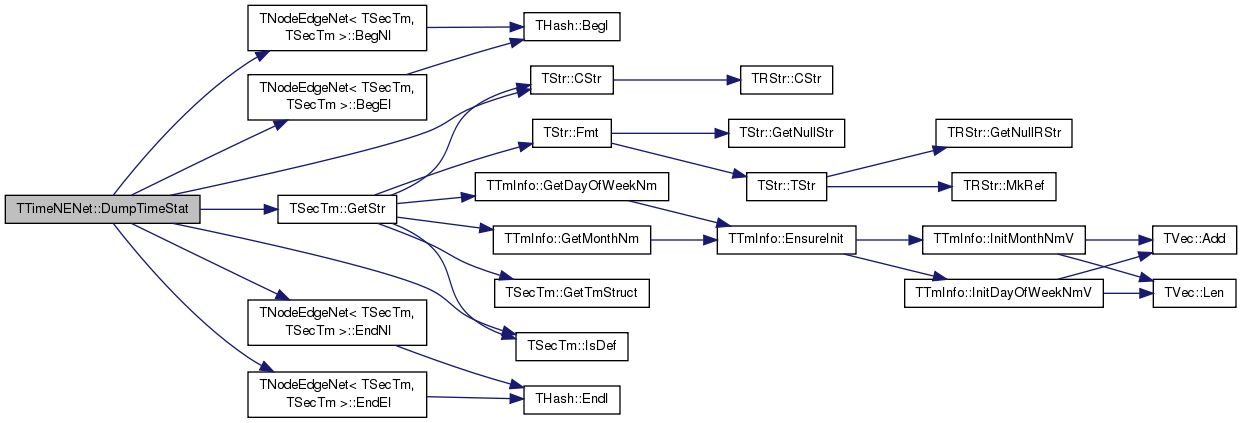
| PTimeNENet TTimeNENet::Get1stEdgeNet | ( | ) | const |
Definition at line 627 of file timenet.cpp.
References THashSet< TKey, THashFunc >::AddKey(), TNodeEdgeNet< TSecTm, TSecTm >::BegNI(), TNodeEdgeNet< TSecTm, TSecTm >::EndNI(), TNodeEdgeNet< TSecTm, TSecTm >::GetEdges(), TNodeEdgeNet< TSecTm, TSecTm >::GetEI(), GetEIdByTm(), TNodeEdgeNet< TSecTm, TSecTm >::GetNodes(), THashSet< TKey, THashFunc >::IsKey(), TVec< TVal, TSizeTy >::Len(), TMath::Mn(), TMath::Mx(), and New().
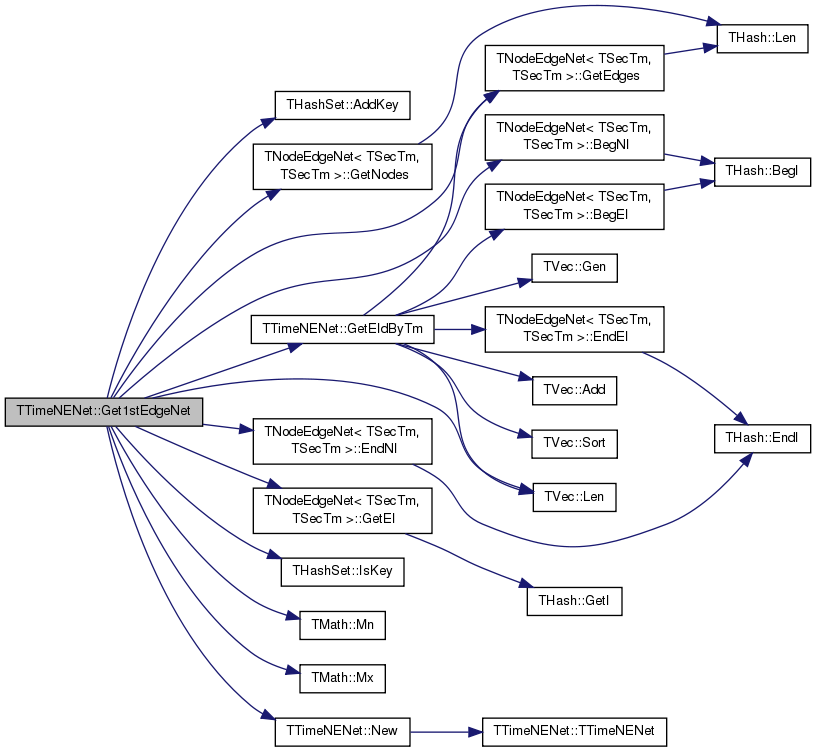
| void TTimeNENet::GetEdgeBuckets | ( | const int | EdgesPerBucket, |
| TTimeNet::TTmBucketV & | TmBucketV | ||
| ) | const |
Definition at line 844 of file timenet.cpp.
References TVec< TVal, TSizeTy >::Add(), TVec< TVal, TSizeTy >::Gen(), GetEIdByTm(), and TVec< TVal, TSizeTy >::Len().
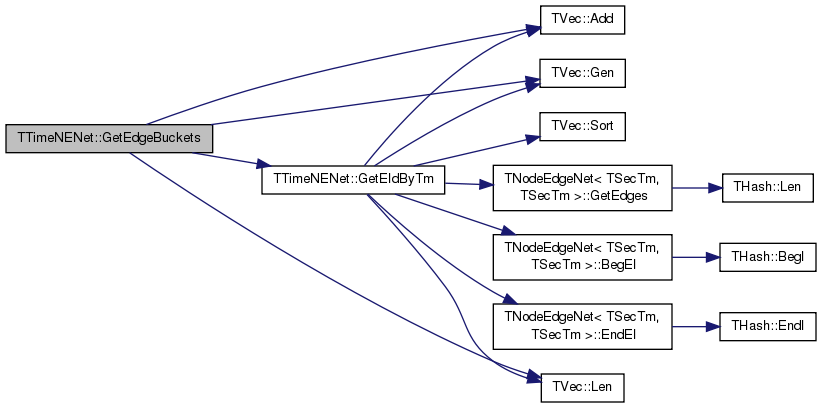
| void TTimeNENet::GetEdgeTmBuckets | ( | const TTmUnit & | GroupBy, |
| TTimeNet::TTmBucketV & | TmBucketV | ||
| ) | const |
Definition at line 815 of file timenet.cpp.
References TVec< TVal, TSizeTy >::Add(), THash< TKey, TDat, THashFunc >::AddKey(), TTimeNet::TTmBucket::BegTm, TVec< TVal, TSizeTy >::Gen(), TSecTm::GetAbsSecs(), THash< TKey, TDat, THashFunc >::GetDat(), TNodeEdgeNet< TSecTm, TSecTm >::GetEDat(), GetEIdByTm(), THash< TKey, TDat, THashFunc >::GetKeyDatPrV(), THash< TKey, TDat, THashFunc >::IsKey(), TVec< TVal, TSizeTy >::Len(), TTimeNet::TTmBucket::NIdV, TSecTm::Round(), and TVec< TVal, TSizeTy >::Sort().
Referenced by PlotEffDiam(), and TimeGrowth().
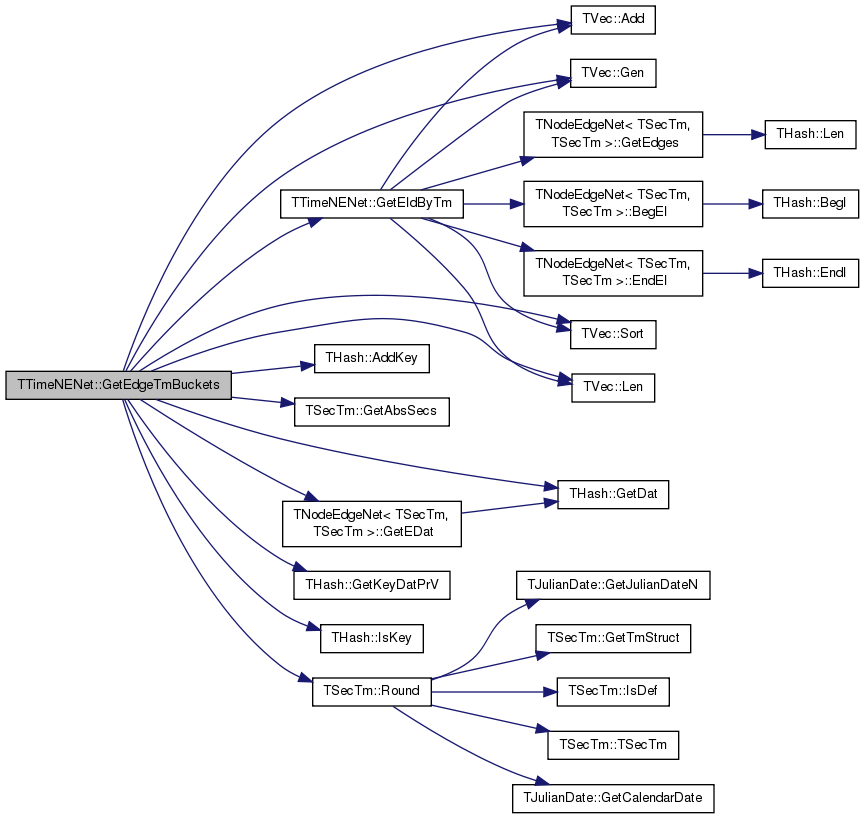

| void TTimeNENet::GetEIdByTm | ( | TIntV & | EIdV | ) | const |
Definition at line 786 of file timenet.cpp.
References TVec< TVal, TSizeTy >::Add(), TNodeEdgeNet< TSecTm, TSecTm >::BegEI(), TNodeEdgeNet< TSecTm, TSecTm >::EndEI(), TVec< TVal, TSizeTy >::Gen(), TNodeEdgeNet< TSecTm, TSecTm >::GetEdges(), TVec< TVal, TSizeTy >::Len(), and TVec< TVal, TSizeTy >::Sort().
Referenced by Get1stEdgeNet(), GetEdgeBuckets(), GetEdgeTmBuckets(), GetTriadEdges(), SaveEdgeTm(), and SetRndEdgeTimes().
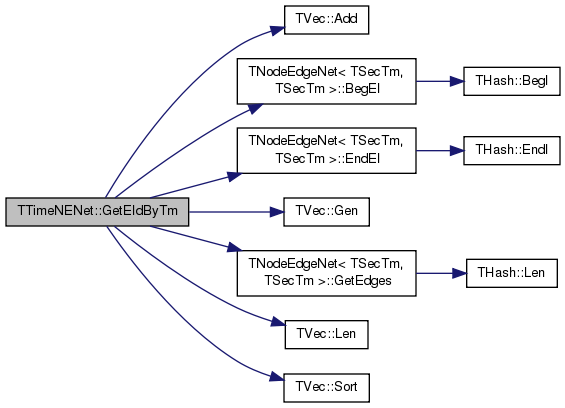
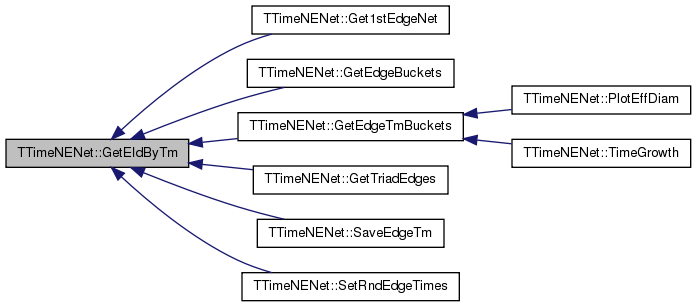
| PTimeNENet TTimeNENet::GetESubGraph | ( | const TIntV & | EIdV | ) | const |
Definition at line 666 of file timenet.cpp.
References TNodeEdgeNet< TNodeData, TEdgeData >::AddEdge(), TNodeEdgeNet< TNodeData, TEdgeData >::AddNode(), TNodeEdgeNet< TNodeData, TEdgeData >::Defrag(), TNodeEdgeNet< TSecTm, TSecTm >::GetEI(), TNodeEdgeNet< TSecTm, TSecTm >::GetNI(), TNodeEdgeNet< TNodeData, TEdgeData >::IsNode(), TVec< TVal, TSizeTy >::Len(), New(), and TNodeEdgeNet< TNodeData, TEdgeData >::Reserve().
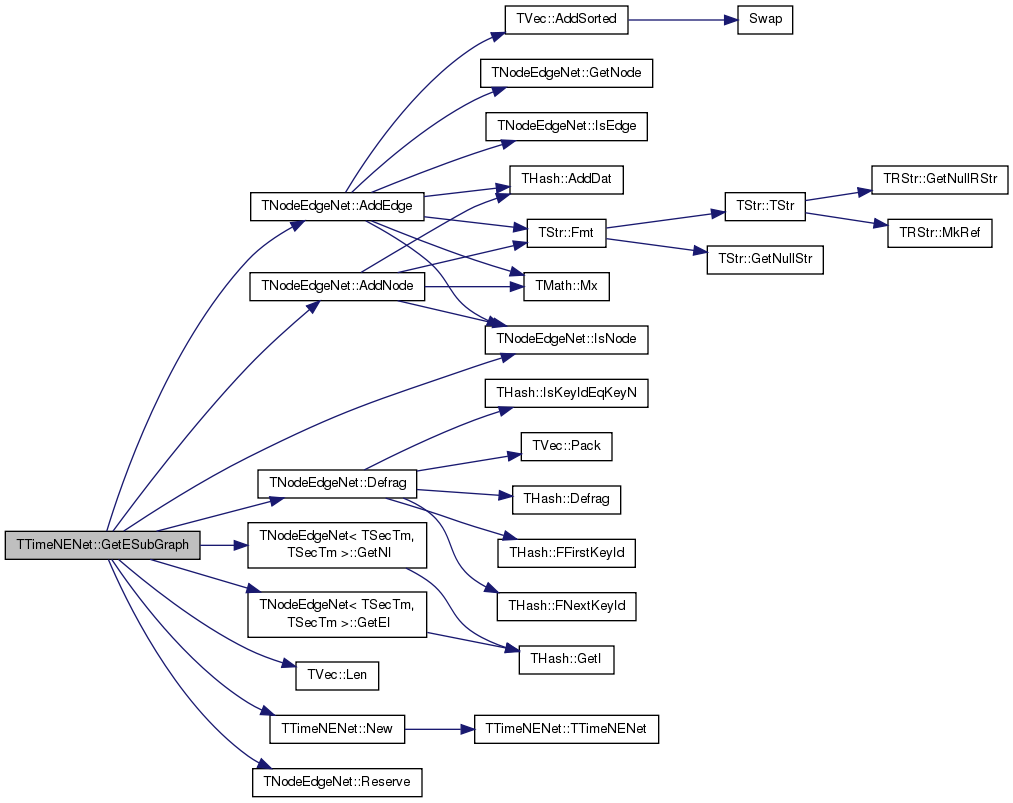
|
static |
Definition at line 1224 of file timenet.cpp.
References TRnd::GetUniDevInt(), New(), and TInt::Rnd.

| PTimeNENet TTimeNENet::GetGraphUpToTm | ( | const TSecTm & | MaxEdgeTm | ) | const |
Definition at line 683 of file timenet.cpp.
References TNodeEdgeNet< TNodeData, TEdgeData >::AddEdge(), TNodeEdgeNet< TNodeData, TEdgeData >::AddNode(), TNodeEdgeNet< TSecTm, TSecTm >::BegEI(), TNodeEdgeNet< TNodeData, TEdgeData >::Defrag(), TNodeEdgeNet< TSecTm, TSecTm >::EndEI(), TNodeEdgeNet< TSecTm, TSecTm >::GetNI(), IAssert, TSecTm::IsDef(), TNodeEdgeNet< TNodeData, TEdgeData >::IsNode(), and New().
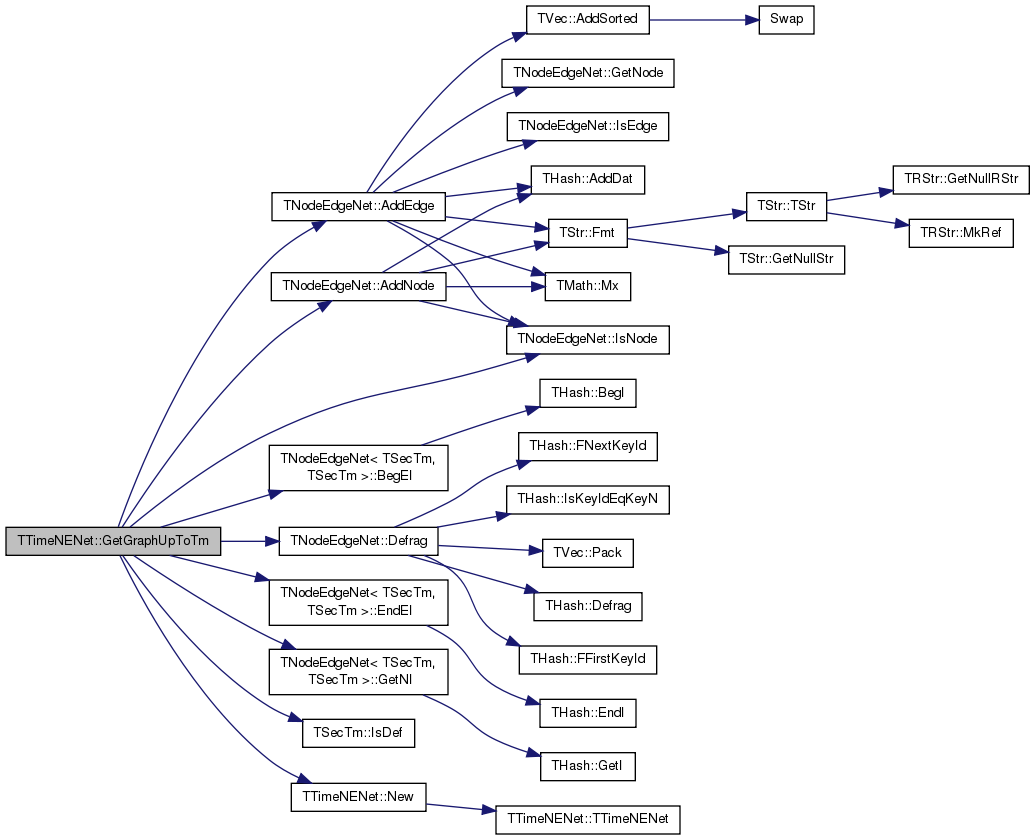
| void TTimeNENet::GetNIdByTm | ( | TIntV & | NIdV | ) | const |
Definition at line 776 of file timenet.cpp.
References TVec< TVal, TSizeTy >::Add(), TNodeEdgeNet< TSecTm, TSecTm >::BegNI(), TNodeEdgeNet< TSecTm, TSecTm >::EndNI(), TVec< TVal, TSizeTy >::Gen(), TNodeEdgeNet< TSecTm, TSecTm >::GetNodes(), TVec< TVal, TSizeTy >::Len(), and TVec< TVal, TSizeTy >::Sort().
Referenced by GetNodeBuckets(), and GetTmBuckets().
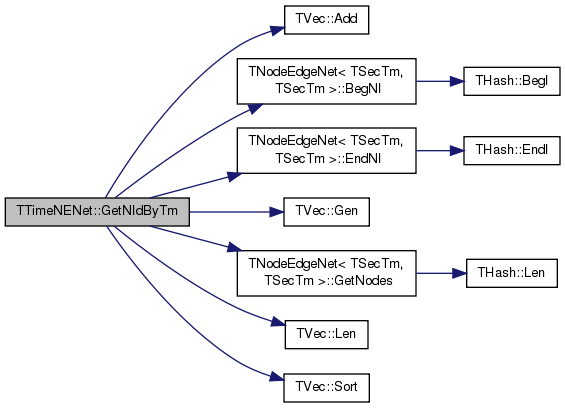

| void TTimeNENet::GetNodeBuckets | ( | const int | NodesPerBucket, |
| TTimeNet::TTmBucketV & | TmBucketV | ||
| ) | const |
Definition at line 834 of file timenet.cpp.
References TVec< TVal, TSizeTy >::Add(), TVec< TVal, TSizeTy >::Gen(), GetNIdByTm(), and TVec< TVal, TSizeTy >::Len().
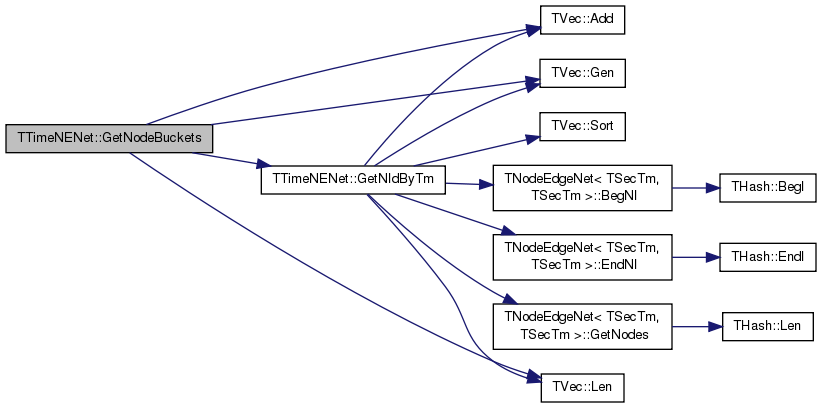
|
static |
Definition at line 1242 of file timenet.cpp.
References TVec< TVal, TSizeTy >::Add(), TRnd::GetUniDevInt(), IAssert, TVec< TVal, TSizeTy >::Len(), New(), and TInt::Rnd.

|
static |
Definition at line 1284 of file timenet.cpp.
References TVec< TVal, TSizeTy >::Add(), THashSet< TKey, THashFunc >::AddKey(), THashSet< TKey, THashFunc >::Clr(), TVec< TVal, TSizeTy >::Len(), THashSet< TKey, THashFunc >::Len(), New(), and TInt::Rnd.
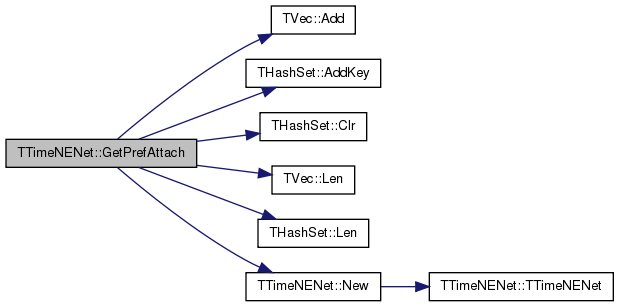
|
static |
Definition at line 1329 of file timenet.cpp.
References New().

| PTimeNENet TTimeNENet::GetSubGraph | ( | const TIntV & | NIdV | ) | const |
Definition at line 645 of file timenet.cpp.
References TNodeEdgeNet< TNodeData, TEdgeData >::AddEdge(), TNodeEdgeNet< TNodeData, TEdgeData >::AddNode(), TNodeEdgeNet< TNodeData, TEdgeData >::Defrag(), TNodeEdgeNet< TSecTm, TSecTm >::GetEI(), TNodeEdgeNet< TSecTm, TSecTm >::GetNDat(), TNodeEdgeNet< TSecTm, TSecTm >::GetNI(), TNodeEdgeNet< TNodeData, TEdgeData >::IsNode(), TVec< TVal, TSizeTy >::Len(), New(), and TNodeEdgeNet< TNodeData, TEdgeData >::Reserve().
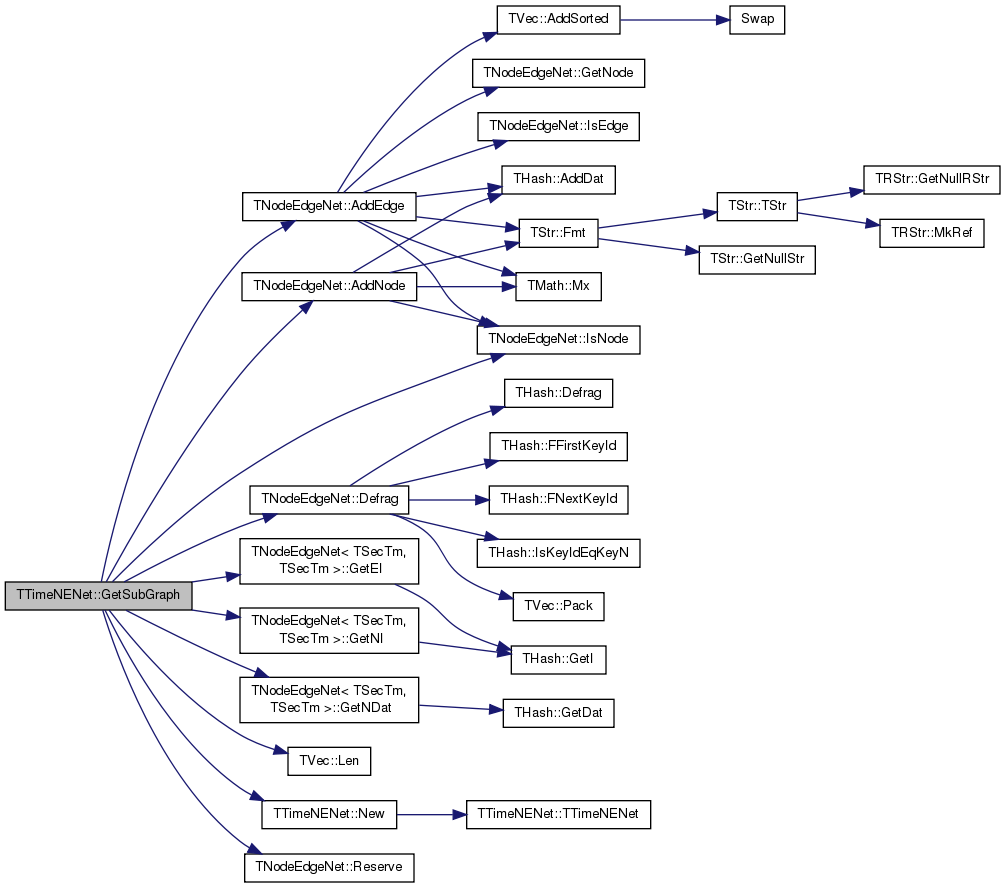
| PTimeNet TTimeNENet::GetTimeNet | ( | ) | const |
Definition at line 610 of file timenet.cpp.
References TNodeEdgeNet< TSecTm, TSecTm >::BegEI(), TNodeEdgeNet< TSecTm, TSecTm >::BegNI(), TNodeEdgeNet< TSecTm, TSecTm >::EndEI(), TNodeEdgeNet< TSecTm, TSecTm >::EndNI(), TNodeEdgeNet< TSecTm, TSecTm >::GetNodes(), and TTimeNet::New().
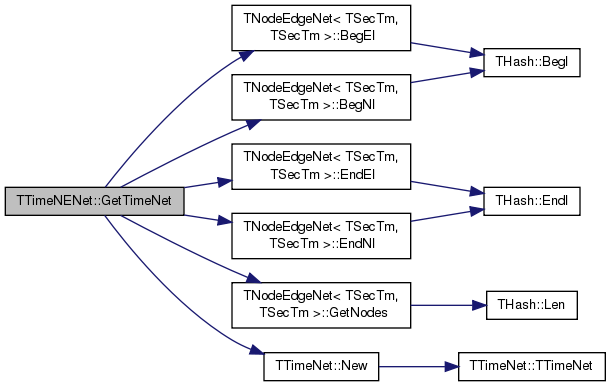
| void TTimeNENet::GetTmBuckets | ( | const TTmUnit & | GroupBy, |
| TTimeNet::TTmBucketV & | TmBucketV | ||
| ) | const |
Definition at line 796 of file timenet.cpp.
References TVec< TVal, TSizeTy >::Add(), THash< TKey, TDat, THashFunc >::AddKey(), TTimeNet::TTmBucket::BegTm, TVec< TVal, TSizeTy >::Gen(), TSecTm::GetAbsSecs(), THash< TKey, TDat, THashFunc >::GetDat(), THash< TKey, TDat, THashFunc >::GetKeyDatPrV(), TNodeEdgeNet< TSecTm, TSecTm >::GetNDat(), GetNIdByTm(), THash< TKey, TDat, THashFunc >::IsKey(), TVec< TVal, TSizeTy >::Len(), TTimeNet::TTmBucket::NIdV, TSecTm::Round(), and TVec< TVal, TSizeTy >::Sort().
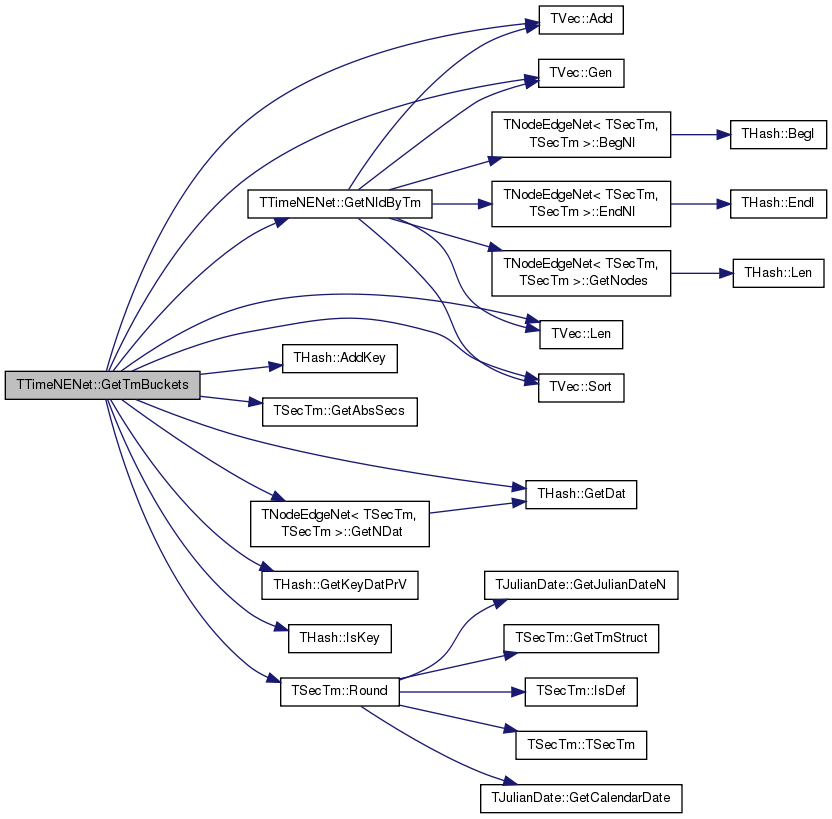
| int TTimeNENet::GetTriadEdges | ( | TIntV & | TriadEIdV | ) | const |
Definition at line 855 of file timenet.cpp.
References TVec< TVal, TSizeTy >::Add(), TUNGraph::AddEdge(), TUNGraph::AddNode(), TVec< TVal, TSizeTy >::Clr(), TSnap::GetCmnNbrs(), TUNGraph::GetEdges(), TNodeEdgeNet< TSecTm, TSecTm >::GetEdges(), TNodeEdgeNet< TSecTm, TSecTm >::GetEI(), GetEIdByTm(), TNodeEdgeNet< TSecTm, TSecTm >::GetNodes(), TExeTm::GetStr(), TUNGraph::IsEdge(), TUNGraph::IsNode(), TVec< TVal, TSizeTy >::Len(), and TUNGraph::New().
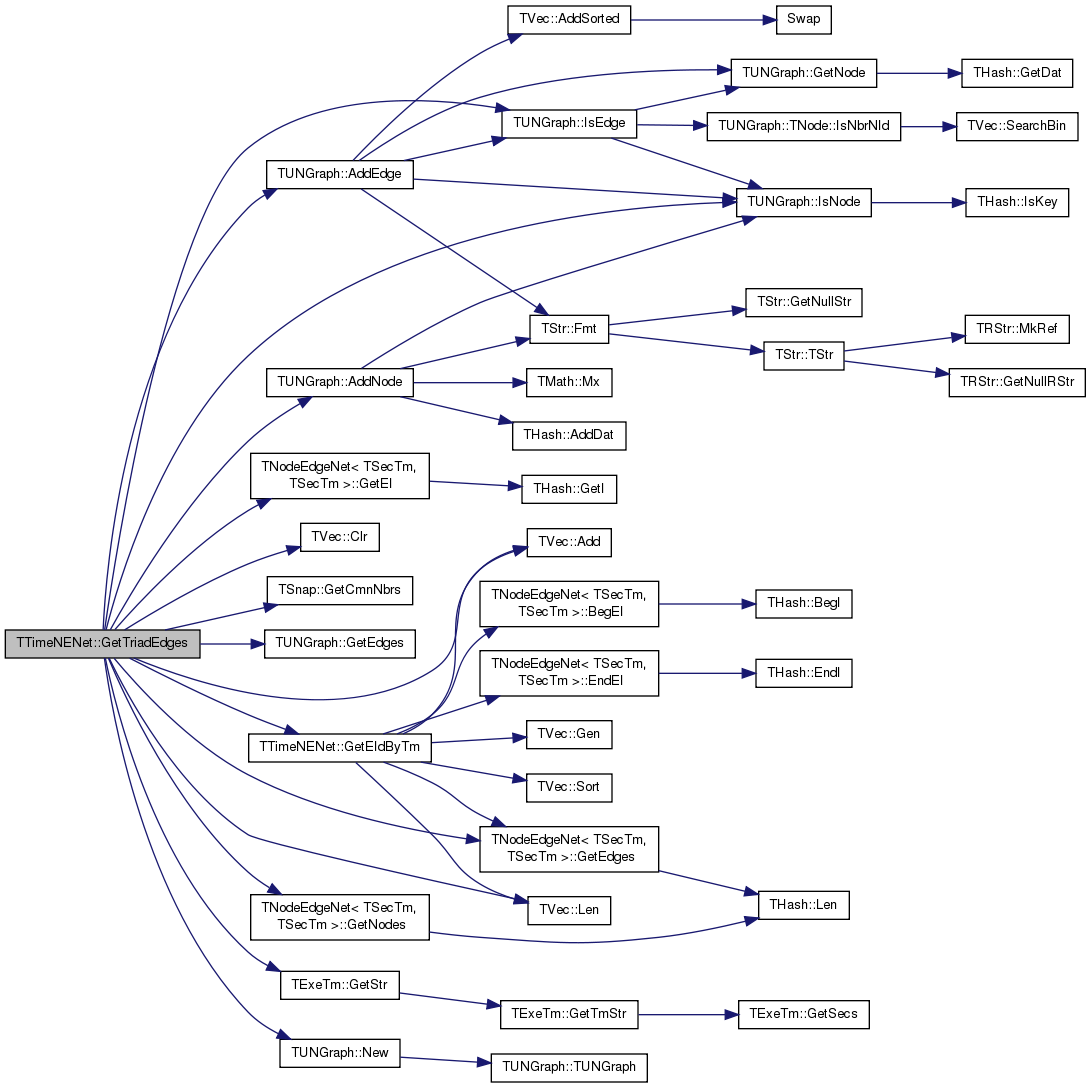
|
inlinestatic |
Definition at line 88 of file timenet.h.
References TTimeNENet().

|
static |
Definition at line 1388 of file timenet.cpp.
References TStrHash< TDat, TStringPool, THashFunc >::AddKey(), TStr::CStr(), TSecTm::GetCurTm(), TSsParser::GetFld(), TSecTm::GetStr(), TExeTm::GetStr(), IAssert, TSsParser::IsCmt(), TSsParser::Len(), Mega, TMath::Mn(), TMath::Mx(), New(), and TSsParser::Next().
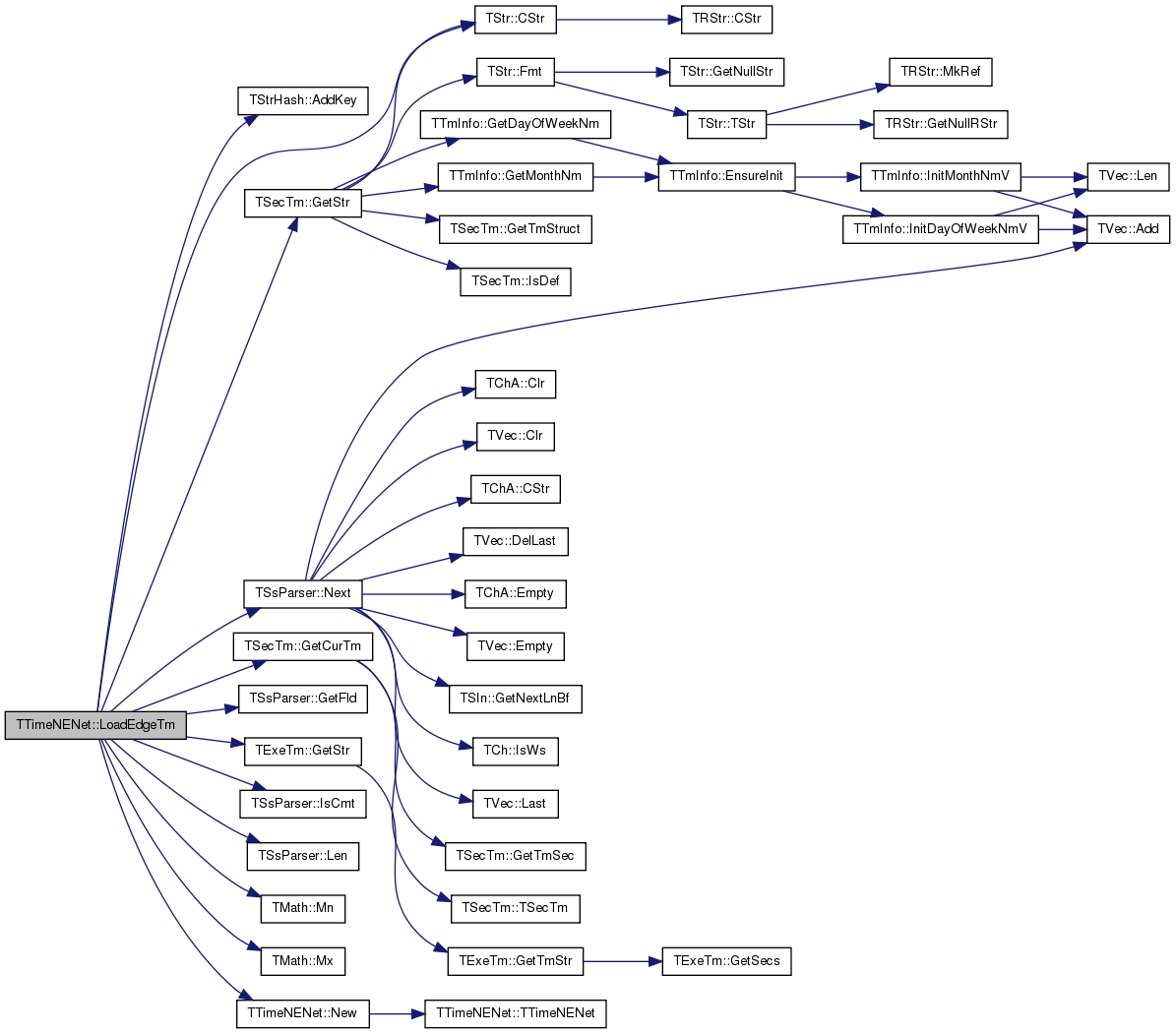
|
static |
Definition at line 1345 of file timenet.cpp.
References TStr::CStr(), TSsParser::GetInt(), TSsParser::GetLineNo(), TSecTm::GetStr(), New(), TSsParser::Next(), and ssfWhiteSep.
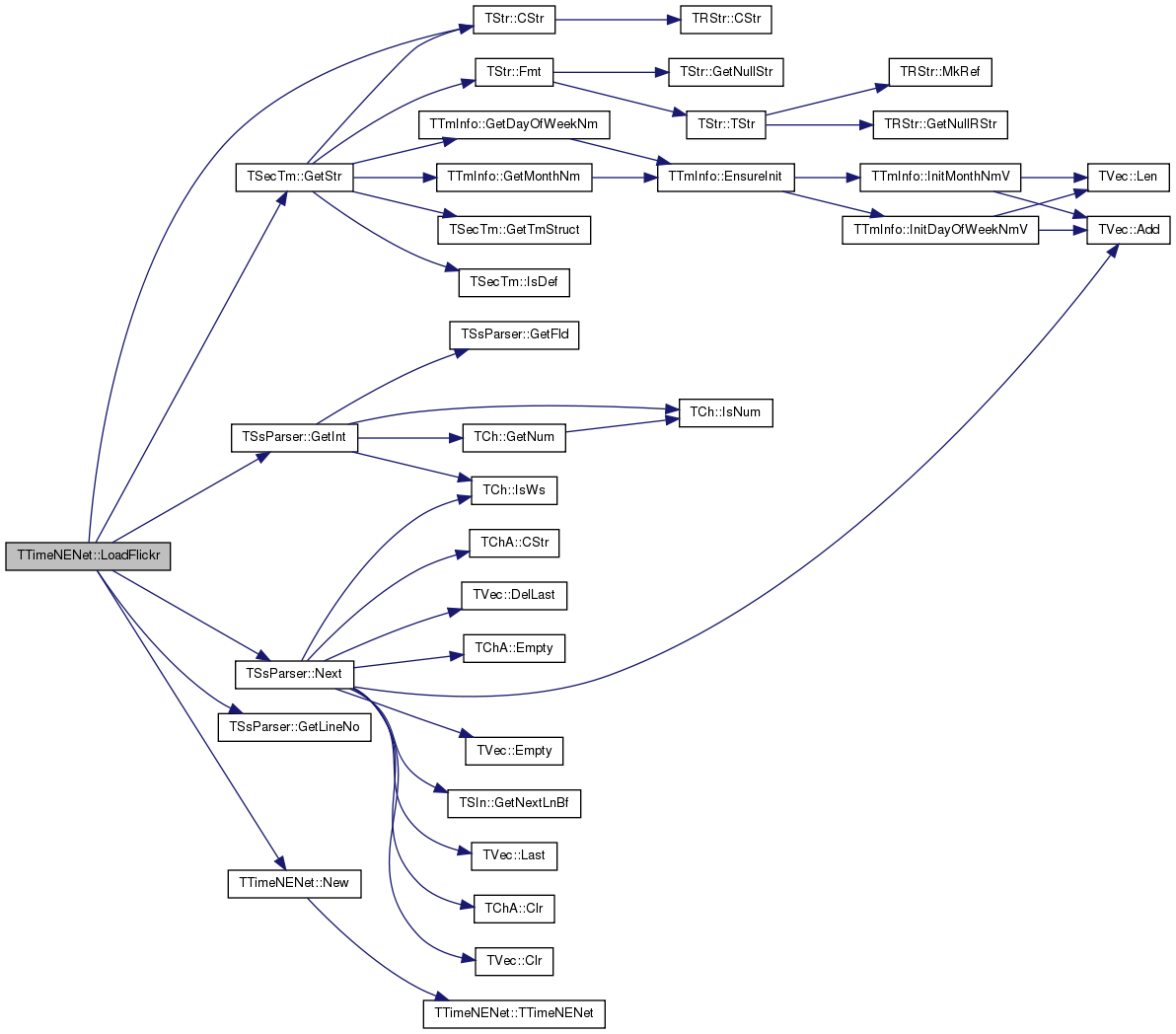
|
inlinestatic |
Definition at line 86 of file timenet.h.
References TTimeNENet().
Referenced by Get1stEdgeNet(), GetESubGraph(), GetGnmRndNet(), GetGraphUpToTm(), GetPrefAttach(), GetSmallNet(), GetSubGraph(), TTimeNet::GetTimeNENet(), LoadEdgeTm(), and LoadFlickr().

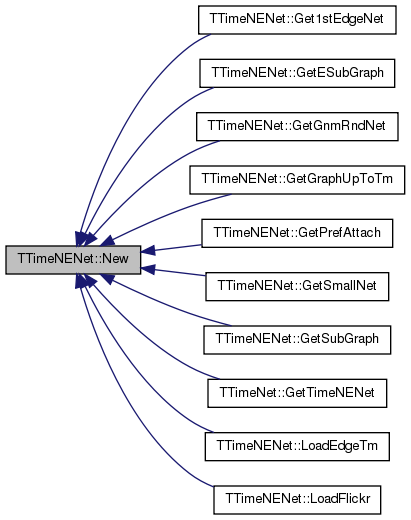
|
inlinestatic |
Definition at line 87 of file timenet.h.
References TTimeNENet().

| TTimeNENet & TTimeNENet::operator= | ( | const TTimeNENet & | TimeNet | ) |
Definition at line 603 of file timenet.cpp.
References TNodeEdgeNet< TSecTm, TSecTm >::operator=().

| void TTimeNENet::PlotEffDiam | ( | const TStr & | FNmPref, |
| const TStr & | Desc, | ||
| const TTmUnit & | GroupBy, | ||
| const TSecTm & | StartTm, | ||
| const int & | NDiamRuns = 10, |
||
| const bool & | OnlyWcc = false |
||
| ) | const |
Definition at line 932 of file timenet.cpp.
References TVec< TVal, TSizeTy >::Add(), TGnuPlot::AddErrBar(), TVec< TVal, TSizeTy >::AddV(), TStr::CStr(), TStr::Fmt(), TSnap::GetAnfEffDiam(), TNodeEdgeNet< TSecTm, TSecTm >::GetEdges(), GetEdgeTmBuckets(), TSnap::GetMxWcc(), TNGraph::GetNodes(), TNodeEdgeNet< TSecTm, TSecTm >::GetNodes(), TStr::GetNullStr(), TExeTm::GetTmStr(), TTmInfo::GetTmUnitStr(), TVec< TVal, TSizeTy >::Len(), TGnuPlot::SavePng(), TGnuPlot::SetXYLabel(), TVec< TVal, TSizeTy >::Sort(), and TExeTm::Tick().
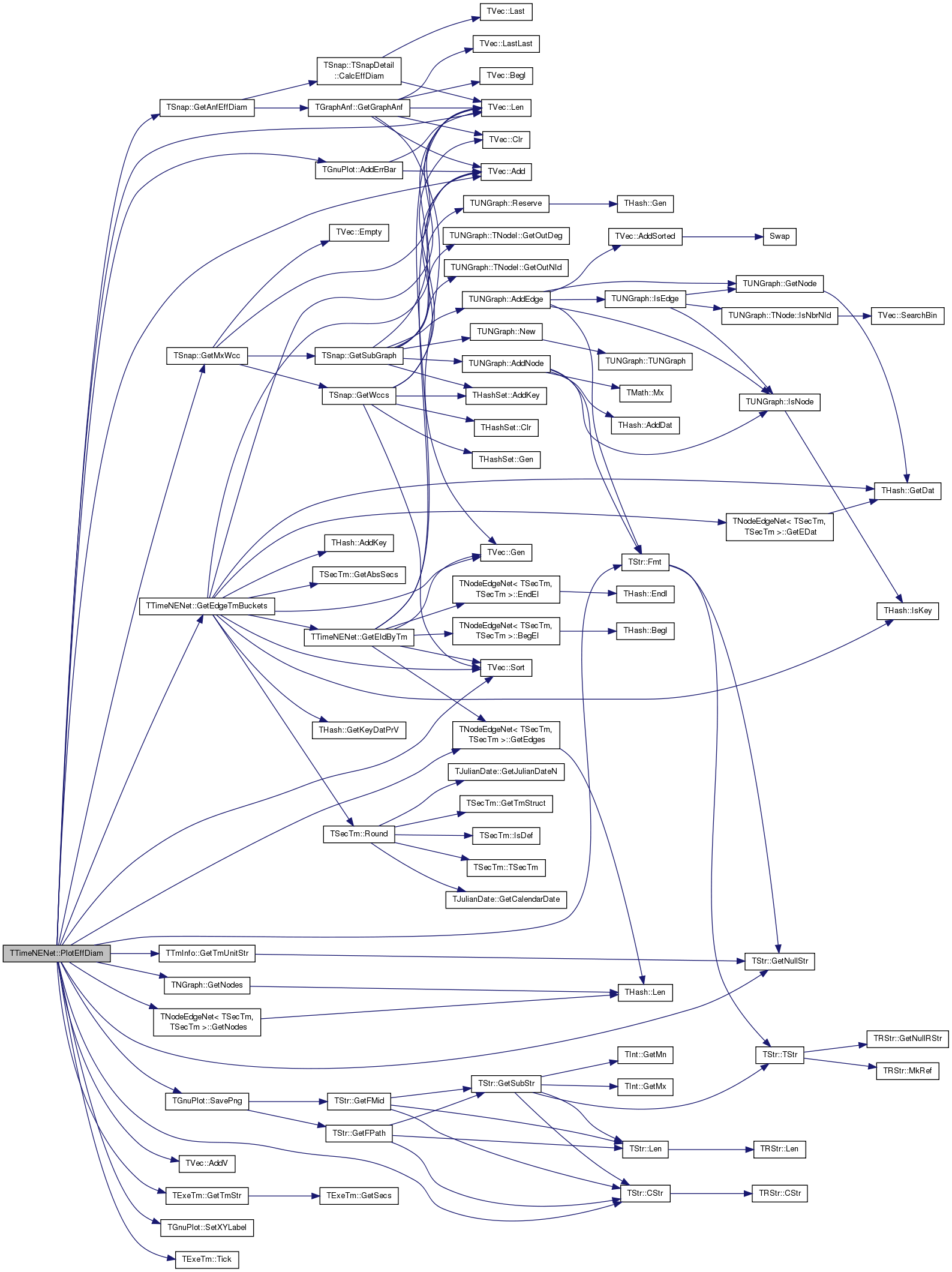
| void TTimeNENet::PlotMissingPast | ( | const TStr & | FNmPref, |
| const TStr & | Desc, | ||
| const TTmUnit & | TmUnit, | ||
| const TSecTm & | DelPreTmEdges, | ||
| const TSecTm & | PostTmDiam, | ||
| const bool & | LinkBWays | ||
| ) |
Definition at line 975 of file timenet.cpp.
References TStr::CStr(), TSecTm::GetStr(), and TTmInfo::GetTmUnitStr().

|
inlinevirtual |
Saves the network to a (binary) stream SOut.
Reimplemented from TNodeEdgeNet< TSecTm, TSecTm >.
Definition at line 85 of file timenet.h.
References TNodeEdgeNet< TSecTm, TSecTm >::Save().

| void TTimeNENet::SaveEdgeTm | ( | const TStr & | EdgeFNm, |
| const bool & | RenumberNId = false, |
||
| const bool & | RelativeTm = false |
||
| ) | const |
Definition at line 1308 of file timenet.cpp.
References THashSet< TKey, THashFunc >::AddKey(), TStr::CStr(), THashSet< TKey, THashFunc >::Gen(), TSecTm::GetAbsSecs(), TNodeEdgeNet< TSecTm, TSecTm >::GetEDat(), TNodeEdgeNet< TSecTm, TSecTm >::GetEI(), GetEIdByTm(), THashSet< TKey, THashFunc >::GetKeyId(), TNodeEdgeNet< TSecTm, TSecTm >::GetNodes(), and TVec< TVal, TSizeTy >::Len().
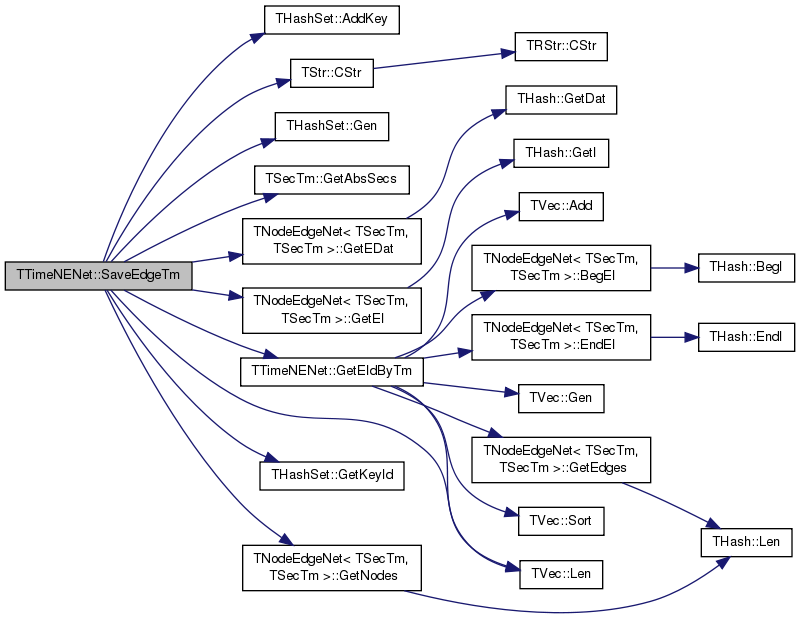
| void TTimeNENet::SetNodeTmToFirstEdgeTm | ( | ) |
Definition at line 723 of file timenet.cpp.
References TNodeEdgeNet< TSecTm, TSecTm >::BegNI(), TNodeEdgeNet< TSecTm, TSecTm >::EndNI(), TNodeEdgeNet< TSecTm, TSecTm >::GetEDat(), TNodeEdgeNet< TSecTm, TSecTm >::GetNDat(), TNodeEdgeNet< TSecTm, TSecTm >::GetNodes(), IAssert, and TSecTm::IsDef().
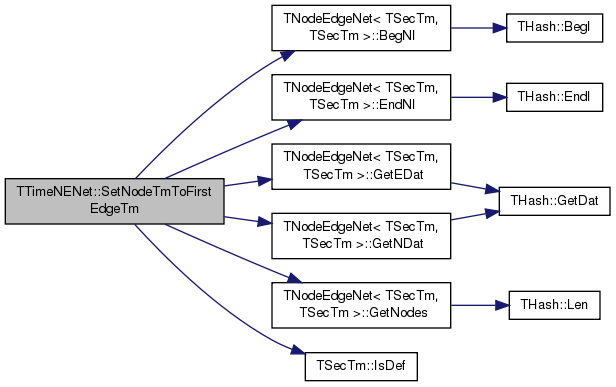
| void TTimeNENet::SetRndEdgeTimes | ( | const int & | MinTmEdge = 0 | ) |
Definition at line 742 of file timenet.cpp.
References TVec< TVal, TSizeTy >::Add(), TNodeEdgeNet< TSecTm, TSecTm >::GetEDat(), TNodeEdgeNet< TSecTm, TSecTm >::GetEdges(), GetEIdByTm(), TVec< TVal, TSizeTy >::Len(), TInt::Rnd, TVec< TVal, TSizeTy >::Swap(), and UpdateNodeTimes().
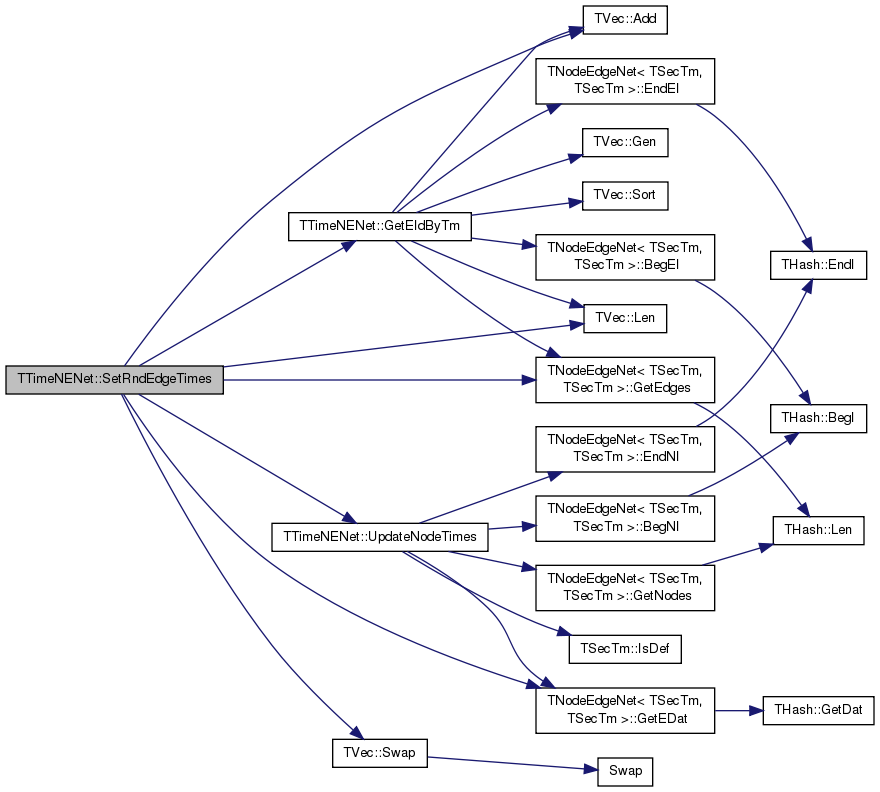
| void TTimeNENet::SortNodeEdgeTimes | ( | ) |
Definition at line 701 of file timenet.cpp.
References TNodeEdgeNet< TSecTm, TSecTm >::EdgeH, TNodeEdgeNet< TSecTm, TSecTm >::NodeH, and THash< TKey, TDat, THashFunc >::SortByDat().

| PGStatVec TTimeNENet::TimeGrowth | ( | const TTmUnit & | TimeStep, |
| const TFSet & | TakeStat, | ||
| const TSecTm & | StartTm = TSecTm(1) |
||
| ) | const |
Definition at line 876 of file timenet.cpp.
References TVec< TVal, TSizeTy >::AddV(), GetEdgeTmBuckets(), TSnap::GetESubGraph(), TExeTm::GetTmStr(), TVec< TVal, TSizeTy >::Len(), TGStatVec::New(), and TExeTm::Tick().
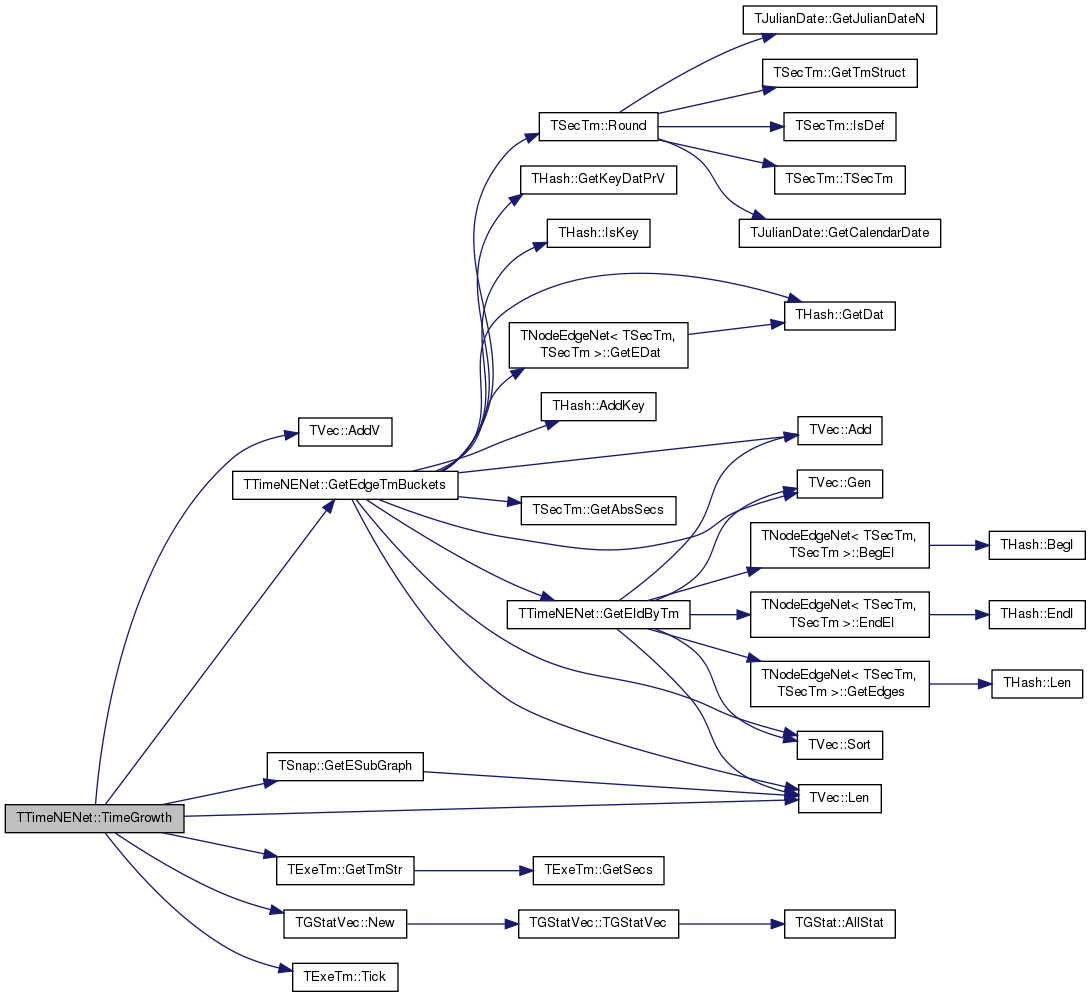
| PGStatVec TTimeNENet::TimeGrowth | ( | const TStr & | FNmPref, |
| const TStr & | Desc, | ||
| const TFSet & | TakeStat, | ||
| const int & | NDiamRuns, | ||
| const TTmUnit & | TmUnit, | ||
| const int & | TakeNTmUnits, | ||
| const bool & | LinkBWays | ||
| ) | const |
Definition at line 896 of file timenet.cpp.
References TVec< TVal, TSizeTy >::Add(), TVec< TVal, TSizeTy >::AddV(), TVec< TVal, TSizeTy >::Clr(), TStr::CStr(), TStr::Fmt(), GetEdgeTmBuckets(), TSnap::GetESubGraph(), TExeTm::GetTmStr(), TVec< TVal, TSizeTy >::Len(), TGStat::NDiamRuns, TGStatVec::New(), TPt< TRec >::Save(), and TExeTm::Tick().
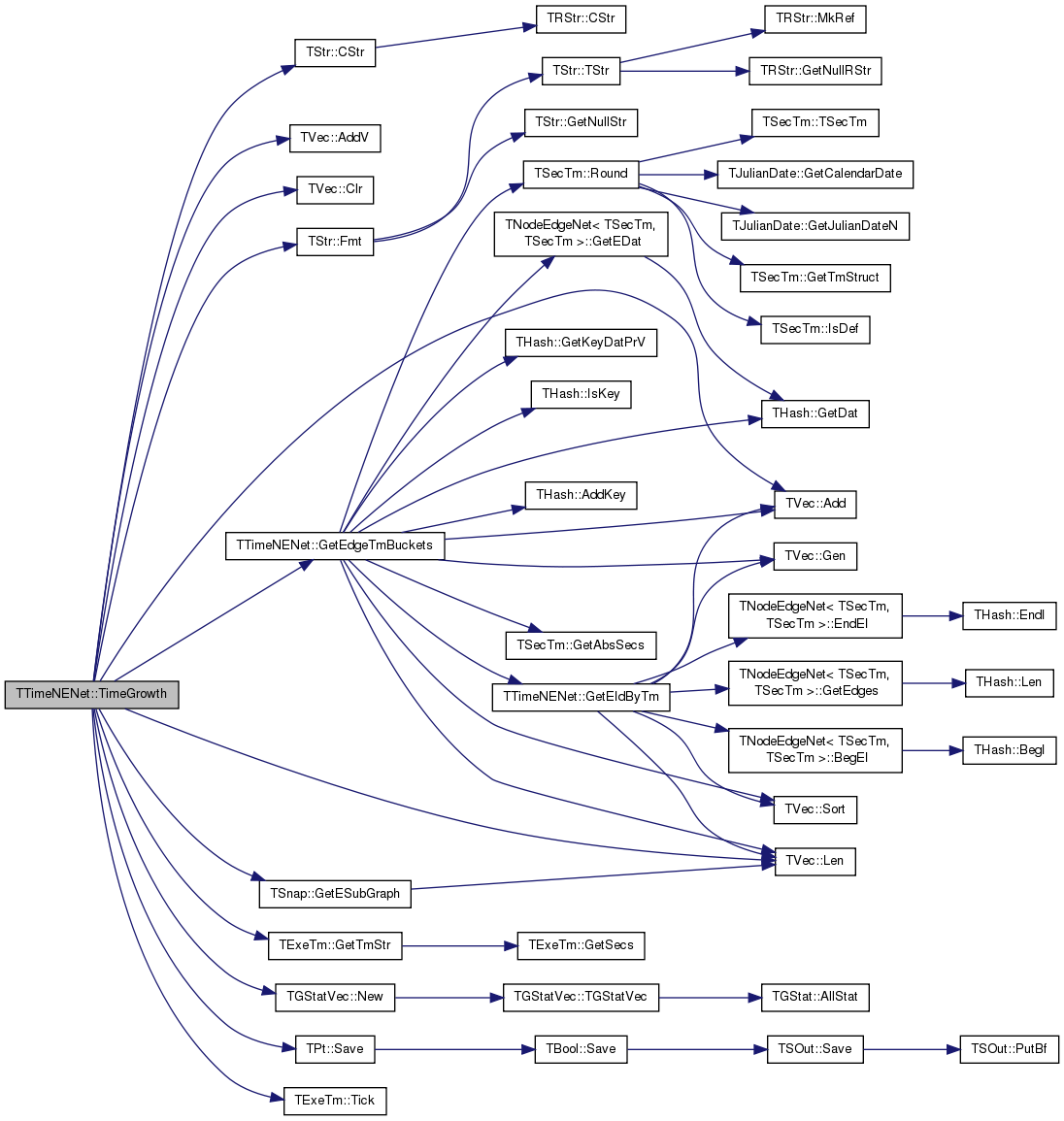
| void TTimeNENet::UpdateNodeTimes | ( | ) |
Definition at line 707 of file timenet.cpp.
References TNodeEdgeNet< TSecTm, TSecTm >::BegNI(), TNodeEdgeNet< TSecTm, TSecTm >::EndNI(), TNodeEdgeNet< TSecTm, TSecTm >::GetEDat(), TNodeEdgeNet< TSecTm, TSecTm >::GetNodes(), and TSecTm::IsDef().
Referenced by SetRndEdgeTimes().
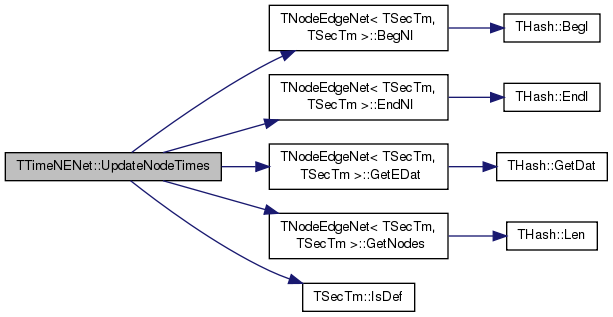

|
friend |